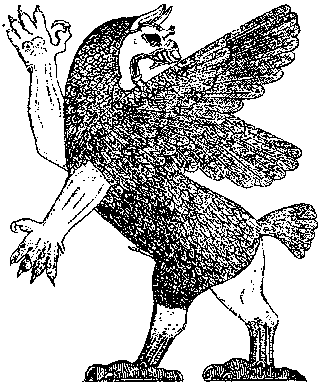
Enuma Elish 6The Babylonian Creation Myth
6 Mode of creation in Enuma ElishWhen it comes to the actual creation of the world, which is my main interest in the epic, Enuma Elish has two separate accounts of it. The first one is in the beginning, where the waters of Tiamat and Apsu are joined, and the second one is when Marduk has killed Tiamat and uses her corpse to build the world. The similarity to Genesis is obvious: In Genesis I the first creation is done in seven days, in Genesis II it is done again, but in a different order and with differing methods.
Abstract and concrete creationGenesis I and II differ mainly in how God goes about creating the world. In the first version he does it simply by naming the parts of the world, one after the other. By naming them, he creates them out of nothing. This I would like to describe as an abstract way of creation. In Genesis II, on the other hand, He uses existing materials, such as earth and His own breath, and lets Adam name the animals, a naming that is not a way of creating them. This creation is concrete, as if done by a craftsman.The two creations in Enuma Elish can be categorized in the same way: The first one, where the world is non-existent because nothing has been named, and gods appear from the mixing of salt and fresh water, is quite abstract. The second creation, where Marduk makes the world out of Tiamat’s corpse, is terribly concrete. About the two versions of creation in the Bible, it is generally accepted that they are of separate origins. They differ in style, and they contradict each other to the extent that it is hard to understand why they are both included in the book. The same can be said about the two versions in Enuma Elish, although this has not been established among experts. The versions don’t obviously contradict each other, but the first world creation does contain parts of the world, such as heaven and earth, which later seem to be recreated.
Most of all, it is odd to imagine the gods existing and acting, without somewhere to be. The gods of Enuma Elish are not separate from the world – it is unlikely that such a concept would at all be fathomable to the Babylonians. Enuma Elish claims that they belong to the stars, but the stars belong to heaven, which therefore needs to exist for the gods to have a place to be. And at the very outset, Apsu is an underground freshwater sea, which could hardly be imagined without a ground for it to be under. 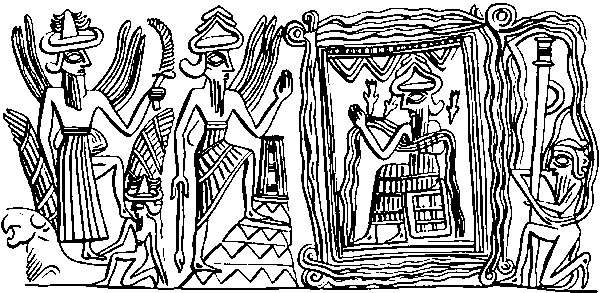 Ea in the Apsu. Cylinder seal from Ur, c. 2350-2150 BC. Even if the two Enuma Elish creation stories are combined, they make little sense. Before Tiamat is killed, how can the world be created out of her – and how can she be killed without a world in which that battle takes place? Such anomalies are common in creation stories, but they should be examined closely in every case. If an anomaly could at all have been discovered at the time of a myths formation, it is likely not to have been there at that time, but to have appeared in later alterations. In Enuma Elish, then, what creation would have made sense to the Babylonians? They obviously regarded water – both salt and fresh – as ever-present, therefore also some kind of land to separate the two at first. That land could have been barren, but there had to be some kind of land. This was peopled by gods only, doing battle with each others until a ruler of them was established. Then, it was time to make a world of mortals, just for the purpose of serving the gods – what other purpose could gods think of? This world and its inhabitants were made by existing materials, different from what the gods were made of.
In short, it makes sense that gods and things divine were created in a more or less abstract manner, since there was very little in the primordial world to use as material. Consequently, mortal beings and that which can perish or dissolve were made in a concrete fashion, befitting their kind (in most myths around the world, gods are not immortal in the sense that they cannot die, but they have no limit to their possible life span). The mechanics of creationAnother way of sorting creation myths than into abstract or concrete, is by looking at the so to say mechanics of them – what leads to what. I see a few categories that can easily be adapted to most – if not all – creation myths:Immediate creation is when the world and everything in it appears at once, as if God of Genesis I said one single “Fiat!” for it all to appear on day one. I have not come across any example of this, probably for the very simple reason that such a world would in fact be very hard for any mind to distinguish from an eternal, un-created world. If there is no process over time of creation, there is no way of either explaining how it appeared, or how far back that would have happened. Chain reaction creation is when events follow each other automatically, because of their nature. A leads to B leads to C. There is no clear will at work, at least not past the very outset of events. There can be a divine will commencing it all, but just with the very start signal. More often, there is no initial will at work. The chain reaction is the case, more or less, in many creation myths, especially in the beginning of them, before they are peopled by many different creatures. Also when creatures appear, they act (as Aristotle would have it, in his Poetics) out of necessity. The beginning of Enuma Elish has these characteristics, when creation begins because of the mixing of waters, and primordial gods give birth to other gods, just like that. Only when the story introduces the conflict started by the younger gods disturbing Apsu and Tiamat with their noise, the Enuma Elish creation story shifts away from this type. Unintentional creation is not necessarily a chain reaction type of creation, but that makes the most sense. Here creation commences as if by accident, with no plan or will involved. Enuma Elish can be an example of it, since it seems that the two waters of Tiamat and Apsu meet without their own will to do so, and therefore it is later quite possible for them to want the whole thing undone. But since the world was not created out of their will, they lack the power to will it undone. It is interesting that Enuma Elish gives no hint of a reason for the creation of the world of the gods, but a reason is introduced for the later creation of mankind. The gods were born for no reason, but everything they create or do to the world, they have their own reason for. Craftsman creation is one where the world is made bit by bit, like handicraft, usually but not always from existing material. Both the Genesis creations belong to this category. In the first one, God makes the world day by day, though not using any material, and in the second one He does the same, but with earth and other extant material. The second creation in Enuma Elish also belongs here. Marduk builds the world by parts of Tiamat’s corpse, arranges celestial events, and puts things in place. He creates both the world and a world order in this fashion.
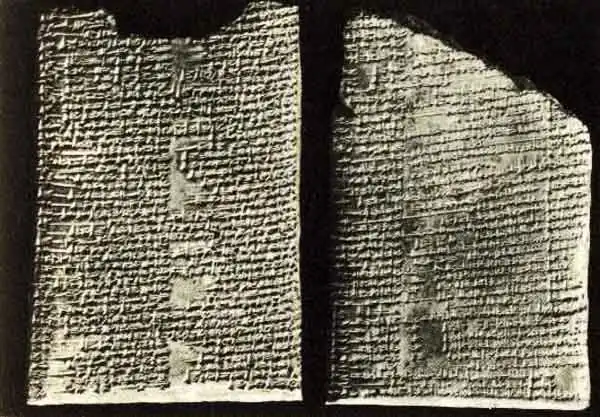 Enuma Elish tablets. The two Enuma Elish creationsAs with the division into abstract or concrete creation, the above categories show that Enuma Elish’s two creation stories differ in type – the first being an unintended chain reaction creation, the second an intended craftsman creation. Also in a Jungian typing of creation myths, the two versions in the Enuma Elish epic must be placed in different categories. Indeed, they have so little in common that they are probably from two separate traditions, as is the case with Genesis I and II. In spite of this similarity between the Enuma Elish creation myths and those of Genesis, they differ so much in character and content that the former are unlikely to have influenced the latter to any degree.Although the first Enuma Elish creation story is the most abstract of them, it would be a mistake to assume that it cannot be the oldest one. There is nothing in our knowledge of past cultures that suggests a lesser understanding of abstractions, but countless examples of the opposite. Babylonian society, and what we know of the Sumerians, show evidence of enough sophistication for abstract reasoning and the use of intricate symbols – before the composition of Enuma Elish. There are two arguments for the first creation in the Enuma Elish epic being the oldest one. The first argument is the simple fact of their order in Enuma Elish. Not only is the creation by Tiamat and Apsu mixing their waters the very beginning of the epic, whereas that of Marduk making the world out of Tiamat’s corpse comes much later, but the second act of creation is dependent on the first one. Without the events of the first creation, the second one just could not take place – there would not even be a Marduk to perform it. That is also at the core of the second argument for the first creation account of Enuma Elish being the oldest: it contains earlier events in the cosmogony. When Marduk commences his creation of the world, much of it is already there. But at the beginning of the first account, there are only Tiamat, Apsu, and some kind of land to initially keep them apart. It is closer to the very beginning of the cosmos. When past cultures considered the creation, they were not likely to halt their efforts of reconstruction before what they could perceive to be the very beginning of it – that is, a time when there was either nothing, or only eternal things. In the first creation of Enuma Elish, the initial state is described – or at least implied – as something having been eternally present. The second creation of Enuma Elish is obviously a later addition, in an effort to give Marduk a significant role in the pantheon, as well as in the creation of the world. To what extent this is an addition or an edition of a previous version with another god than Marduk, is more difficult to sort out. As mentioned earlier, the Enuma Elish story makes the most sense with Ea as the main character all through, and there are other versions in the region where neither Ea nor Marduk, but a third divinity plays the role. Therefore, the second creation account in Enuma Elish must also be a tradition existing before Enuma Elish was written.
We see two different creation accounts, both present for long in the region, with separate origins, but combined into one account early on. Also as such a combined account, the creation story had been present for a long time in the region, and was more than once adapted by different societies, who altered it to fit their needs. The first creation myth of Enuma ElishThe first account, starting with the mixing of Tiamat’s and Apsu’s waters, probably ended by the appearance of Ea. In Enuma Elish, Ea’s appearance and elevation above the other gods makes a natural ending of the very first part of the epic. Right after that, as can be seen in the quoted beginning of Enuma Elish above, the animosity between the gods commences, and seems to imply more gods than have been mentioned so far. Also, they act in ways that don’t give the impression of an original minimal pantheon, largely consisting of gods that represent basic cosmic components, such as the sea and heaven, and space above and below the horizon.
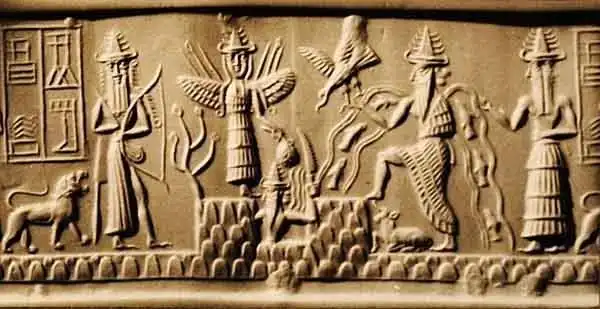 The god Ea (second from right) on the Adda Seal, c. 2300 BC. Behind Ea is two-faced messenger Usumu. In front of him is the sun god Shamash, and next the winged goddess Ishtar. So, the first Enuma Elish account ends with Ea, who by his name Nudimmud was a Sumerian creation god. In an original version of this account it was probably Ea – by whatever name he had at that time – who created the rest of the world and its inhabitants. This extant part of the story was simply his genealogy. How would he have created the world, if not in the way described later on in Enuma Elish? Here, the first two lines of the Enuma Elish epic may hold a clue. They mention naming: the skies and the earth were not yet named. There is no naming taking place as a mode of creation in Enuma Elish, wherefore these lines seem rather out of place. But naming as an act of significance is in line with later accounts in Enuma Elish of spells used by Tiamat and others to perform their deeds. Of course, it also brings Genesis I to mind. An original Ea might in his wisdom have started the naming, both in the sense of thereby adding to creation and in the sense of ordering it and giving the gods their proper places among the stars. He was also the one to create mankind and to foster it through its first ignorant period. Such a creator god is quite likely to have had an influence on Genesis I. But the initial Enuma Elish events of creation contain no naming, which implies that such magic is secondary and lesser. Instead, the world begins with water. A primordial sea is present in many creation myths, and easily explained: Nothing seems more lasting and unchangeable to primordial man than the sea. It extends seemingly without end, it gnaws on land and reclaims it with ease, it may storm but never loses its form, it may retreat but always returns, and so on. Even the sun and moon and stars seem less stable – they appear and disappear, they move across the sky and lack a definite resting place. To primordial man, the sea could be nothing but eternal. In the first creation of Enuma Elish, there is not one ocean, but two. This is quite unique. I have not come across another creation myth with this division. Tiamat is the saltwater ocean, and Apsu one of fresh water. The latter represents underground water, as found sometimes by digging. The two waters are distinctly different – one drinkable and the other not. It makes sense to make this eternal element in its two forms the mixture by which all else is created. Actually, when one mixes the two waters it all becomes saltwater, which explains the supremacy of Tiamat in Enuma Elish. She has to be the most powerful one, since her water is. Also, it is easy to make saltwater out of fresh water by adding some of the former to the latter, but to primordial man the reverse was impossible. The fact that Tiamat’s water is undrinkable is another example of her power – and danger. One question arises: Saltwater being undrinkable and untamable, but fresh water being essential for survival, would not the former represent death and the latter life? In Enuma Elish it seems to be the other way around. Tiamat is the mother, giving birth to the gods and the world, whereas Apsu has little more to do than to participate initially, and then he becomes a symbol of the netherworld land of the dead. Of course, these things are later on in the Enuma Elish epic, but they are still an anomaly of sorts, at least a mystery. Also, it is not easy to see reasons for their gender. Tiamat may be female because of her superior size, a womb grand enough to give birth to the world, and Apsu might be male in line with the minuteness of his contribution to creation, by some initial drops of his water. Tiamat as the world mother suggests that although Apsu is mentioned first in Enuma Elish, if anyone of them preceded the other it would have been Tiamat. There may have been a beginning before the now known beginning, where Tiamat was alone, and land as well as a freshwater sea inside of it emerged from her depth. There are several creation myths with that kind of beginning.
This would also explain why Apsu and not Tiamat is connected to the world of the dead: Tiamat was the creator of all, including Apsu, and just as Apsu after his intercourse with Tiamat is sunken into the netherworld, so is any living being after some time on the surface of Tiamat’s world. 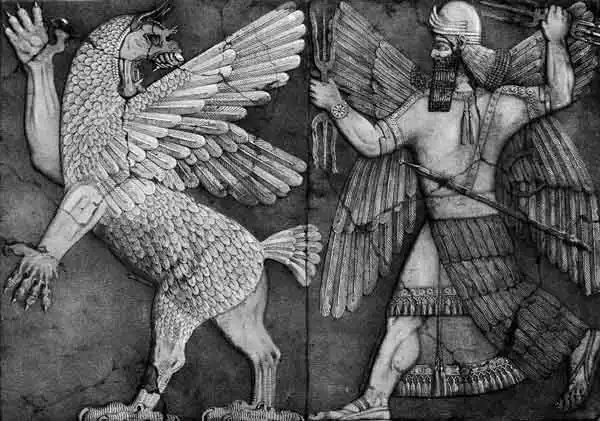 Marduk chases Tiamat. Mankind as servantsI will not explore the second creation myth of Enuma Elish, the one where Marduk makes the world from Tiamat’s corpse. Suffice to say that it suggests another beginning than the one in the Enuma Elish epic. That beginning could be a sole creator like the sea of Tiamat. This is even quite likely. A primordial sea goddess killed by her offspring, in order to make the world out of her flesh. But I doubt that the second Enuma Elish creation story had a beginning of its own. Instead, it seems to be an addition to the first creation, taking up slightly before its end, with some altering at the point of transition.There is one element in the later Enuma Elish creation story that is more interesting to examine: the role of mankind. The gods agree about a sole purpose for creating mankind – as servants to the gods. To the gods this surely makes perfect sense, but to the people inventing and adapting the myth? Enuma Elish shows the explanation clearly. This is not a myth for the people, but for their ruler. The epic glorifies Marduk, so that his earthly counterpart the king may be equally praised. Mankind is to serve the king as they were created to serve the gods.
But what need could gods have of mortal servants? Considering the clamor they have had among themselves, would they really be inclined to introduce additional players to the arena? The work that the gods express the need to be relieved from is that of mortals on earth, and not of gods among the stars. This is also suggested by the older epic of Atrahasis, mentioned above, where gods were more like men: It is a poetic description of what life seems to be all about: an endless chain of parents laying down their tools and passing on to their offspring the cyclic work on the land.
LiteratureCotterell, Arthur: The illustrated encyclopedia of myth & legend, London 1992.Dalley, Stephanie: Myths from Mesopotamia, Oxford 2000. Eliade, Mircea: Essential Sacred Writings From Around the World, New York 1992 (first published as From Primitives to Zen, 1967). Eliade, Mircea: The Myth of the Eternal Return, or Cosmos and History, translated from the French by Willard R. Trask, London 1989 (originally published as Le Mythe de l’éternel retour: archétypes et répétition, Paris 1949). Frazer, James George: The Fear of the Dead in Primitive Religion, London 1933. Freud, Sigmund: Totem and Taboo, translated by A. A. Brill (German original published in 1913), New York 1998. Freud, Sigmund: Moses and Monotheism, translated by Katherine Jones (originally published in 1939), New York 1967. Haldar, Alfred: Det babyloniska skapelseeposet, Stockholm 1952. Jung, Carl G. & Kerényi, Karl: The Science of Mythology, translated by R. F. C. Hull, London 2002 (originally published as Einführung in das Wesen der Mythologie, Amsterdam 1941). King, L. W.: Enuma Elish: The Seven Tableets of Creation, volume I and II, London 1902. Long, Charles H.: Cosmogony, in Mircea Eliade (ed.), The Encyclopedia of Religion, New York 1987. Long, Charles H.: Alpha: The Myths of Creation, Atlanta 1963. Smith, George: The Chaldean Account of Genesis, London 1876. Sproul, Barbara C.: Primal Myths: Creation Myths around the World, San Francisco 1991 (first edition published in 1979). Wikander, Ola: Enuma elish. Det babyloniska skapelseeposet, Stockholm 2005. Weigle, Marta: Creation and Procreation: Feminist Reflections on Mythologies of Cosmogony and Parturition, Philadelphia 1989 (a publication of the American Folklore Society New Series).
1 Enuma Elish: The CreationEnuma ElishThe Babylonian Creation Myth
This article about the Enuma Elish Babylonian Creation Myth was originally written in the year 2007 for a seminar at the Department of History of Ideas, Lund University, as a part of my dissertation in progress on Creation Myths and their patterns of thought. Transforming the text to webpages, I have excluded footnotes, or edited them into the text.
MENUCreation Myths Around the WorldHow stories of the beginning began.
The Meanings of MythologyTheories through history about myth and fable.
Archetypes in MythsThe mythological symbols and what they stand for.
The Logics of MythPatterns of creation.
CREATION MYTHS IN DEPTHCreation in Rig Veda 10:129The paradox of origin, according to an Indian myth.
Genesis 1The first creation story of the bible scrutinized.
Enuma ElishThe ancient Babylonian creation myth.
Xingu Creation of ManThe insoluble solitude of gods and humans.
ContactAbout Cookies
ON MY OTHER WEBSITESPsychoanalysis of MythWhat Sigmund Freud and C. G. Jung thought about myths, their origins and meanings.
Myth of CreationAn introduction to the subject of creation myths and the patterns of thought they reveal.
Cosmos of the AncientsWhat the Greek philosophers believed about the cosmos, their religion and their gods.
Life EnergyThe many ancient and modern life force beliefs all over the world explained and compared.
TaoisticTaoism, the ancient Chinese philosophy of life explained. Also, the complete classic text Tao Te Ching online.
|
 Archetypes of Mythology
Archetypes of Mythology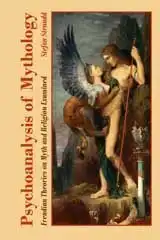 Psychoanalysis of Mythology
Psychoanalysis of Mythology Cosmos of the Ancients
Cosmos of the Ancients Life Energy Encyclopedia
Life Energy Encyclopedia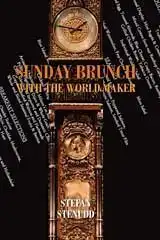 Sunday Brunch with the World Maker
Sunday Brunch with the World Maker Fake Lao Tzu Quotes
Fake Lao Tzu Quotes Stefan Stenudd
Stefan Stenudd